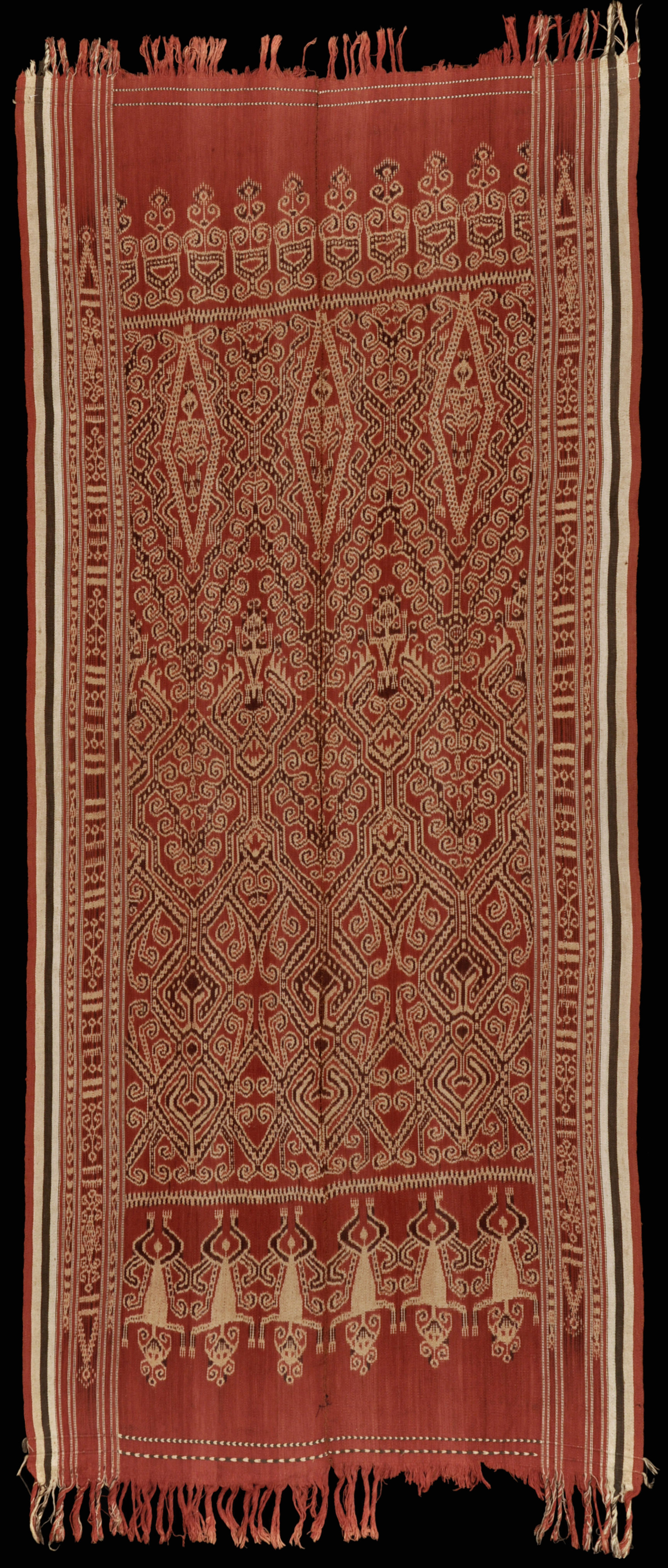| |
 mouse over to magnify mouse over to magnify
| | | | 037 Borneo, Sarawak
Pua kumbu
| | Locale: | Iban Dayak. Simanggang, old 2nd Division. | | Period: | 1920-1930 | | Panels: | 2 | | Design: | Top row motifs are Bali Mabuk, which literally translates as ‘the drunken motif': a headless torso with wavering legs recalls a man whose head has just been lopped off, his headless torso on the verge of falling, not unlike an intoxicated person unsteady on his feet. The main design, from which we know the positioning of the cloth, has two kinds of human figures - one enclosed in a diamond, the other sitting on a pendant. The weaver positioned three coils at one end and two coils at the other. She would have begun knotting with three coils to display her status, not two. Hence, the three coils would sit at the bottom where the design begins. Another set of human figures, engkeramba, decorates the bottom. Curiously, the style of the headdress, with the inward curl, is very similar to that seen of West Timorese cloths (see below), suggesting that this is an archaic motif with wide distribution. Borders with narrow white and dark brick red stripes. | | Size: | 85 x 193 cm (33.4 x 75.9 in) | | Weight: | 595 g (363 g/m2) | | Yarn: | Cotton, hand-spun, coarse | | Comment: | For reasons unknown this pua, while technically accomplished in other respects such as alignment and intricacy of design, is askew. It was probably made by an old weaver who lacked the necessary strength to firmly and consistently beat in the weft, or to maintain an evenly distributed backstrap tension. She may also have had a rare bout of poor judgment in the handling of the warp during the mounting of the warp on frame or loom, causing the warp threads to skew to one side. Skewing results in lack of prestige for the weaver as it lessens aesthetic appreciation, but does not diminish the cloth's potency in ritual use. Natural dyes throughout. Fringes partly missing due to wear. | | Background: | Additional information in chapters on Borneo and Sarawak. | | Published: | Ikat Textiles of the Indonesian Archipelago, 2018.
| | Compare: | 181 244 245 | | Sources: | Information on origin and motifs provided by Vernon Kedit. Similar human figures in border of pua in John Kreifeldt collection, #48, depicted in Hali review of his Woven Power exhibition. See also Gittinger, Splendid Symbols, Fig. 169; Khan Majlis, Indonesische Textilien, Wege zu Goettern und Ahnen, Fig. 682 and p.174/175. Similar cloth also in Gavin, The Women's Warpath, Fig. 93. Chaddon c.s. Iban of Sea Dayak Fabrics, Plate 1c. Note the similarity of the headdress of the figures in the bottom row to those seen on Timorese cloth from Amanuban such as PC 181, 244, 245 | | |
 ©Peter ten Hoopen, 2025
All rights reserved.
|
|


